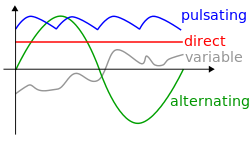Seamless Soldering technology
Solar-hydro-wind combination
Solar Dryer
Solar Distillation
Tesla Solar Roof Tiles and Shingles
Agrivoltaics
Solar Water Heating
Research Development and Demonstration
[...]
HVDC Grid for PV/ STPV and other Renewables
 AC Power (green curve) Direct Current (red curve)[/caption]
Engineers thought again about DC transmission. High power semiconductor devices are now available to efficiently convert AC to DC for transmission, and then back from DC to AC for step down and distribution. Therefore the switch from long distance AC transmission to DC transmission is on its way.
AC Power (green curve) Direct Current (red curve)[/caption]
Engineers thought again about DC transmission. High power semiconductor devices are now available to efficiently convert AC to DC for transmission, and then back from DC to AC for step down and distribution. Therefore the switch from long distance AC transmission to DC transmission is on its way.
